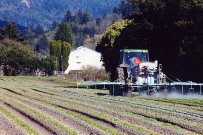Siskiyou Land Conservancy an Important Contributor to the Coho Salmon Recovery Plan
UPDATE (March 1, 2012): NMFS has extended the Coho Recovery Plan comment period to May 4, 2012. Keep checking this site for updates.
************************************************************************
In early January the National Marine Fisheries Service (NMFS) released its long awaited draft Southern Oregon/Northern California Coast (SONCC) Coho Recovery Plan. Though we’ve hardly had a chance to penetrate the 1,400-page document, the first meeting is coming right up:
January 31 – Humboldt Area Foundation 5-8:30 p.m. 373 Indianola Rd. (between Arcata and Eureka)
We have asked NMFS to hold future meetings in Arcata or Eureka proper.
We encourage supporters of North Coast salmonids to attend this meeting, or one of the following:
February 1 – Willits
February 2 – Brookings
February 14 – Yreka
February 15 – Medford area (Central Point)
For more information on these meetings contact Julie Weeder at NMFS: 707-825-5168 or julie.weeder@noaa.gov.
The entire Recovery Plan can be viewed here.
As most of you know, Siskiyou Land Conservancy serves five counties in Northwestern California (Humboldt, Del Norte, Mendocino, Trinity and Siskiyou), representing some of the most important remaining Coho habitat in the West. In this region, the best remaining salmonid habitat by far is on the Smith River. In fact, the Smith River is the most pristine watershed its size on the West Coast of the United States.
However, what the Smith River chapter of the Coho Recovery Plan makes clear is that Coho numbers are plummeting on the Smith as well, veering toward extinction. The Recovery Plan lists the Smith River’s Coho salmon population as a “high extinction risk.” This despite the fact that the majority of the 719-square-mile watershed is in excellent condition, relative to other western streams. Where the Smith’s salmonid habitat is not excellent, according to the Recovery Plan, is at the estuary. And it’s the estuary that Coho salmon love the most. They spend a whole year in fresh water before migrating to sea, so they need the calm pools and abundant food production of an estuary.
The Coho Recovery Plan utilizes information generated by Siskiyou Land Conservancy, and its predecessor the Smith River Project, to illustrate one of the greatest potential threats to the Smith River estuary: Pesticides used to produce 90 percent of the U.S. production of Easter lilies.
The Recovery Plan also makes clear that Rowdy Creek, which feeds the Smith River estuary, is one of the two best remaining Coho streams on the Smith, yet Coho numbers are far lower on Rowdy Creek than they should be. The Recovery Plan offers just one paragraph on an elephant in the Rowdy Creek room: the timber giant Green Diamond owns almost all of the best Coho habitat in the watershed.
Siskiyou Land Conservancy is developing comments on the Coho Recovery Plan, which we will post here. Our supporters should try to comment as well, asking for reductions of pesticides on lily fields surrounding the estuary, and greater scrutiny of the clear-cutting and road building by Green Diamond that have diminished and eliminated Coho salmon habitat. (Green Diamond also uses pesticides in the watershed.)
Siskiyou Land Conservancy’s Contribution to the Coho Recovery Plan
Since 2004, and on a limited budget, Siskiyou Land Conservancy has been the only NGO, indeed the only organization of any kind to insist on a review and reduction of impacts to the estuary potentially wrought by pesticides.
The Recovery Plan notes that “restoration of the Smith River estuary … is imperative. … Agricultural run-off needs to be addressed to reduce the concentration levels of pesticides reaching the Smith River and its tributaries. … Of particular concern is the lily farming that occurs on the floodplain. One study showed that intense use of pesticides between 1996 and 2000 by lily farmers led to high levels of chemicals including carbofuran, chlorothalonil, diurin, disulfoton, and pentachloronitrobenzene. [The authors should also have listed metam sodium and 1,3-Dichloropropene. Also, pentachloronitrobenzene is no longer used on the Smith River.] Recent testing in the lower Smith River has revealed copper concentrations that may have acute toxic effects and impair olfaction and reproduction of coho salmon (North Coast Regional Water Quality Control Board (NCRWQCB) 2011). The current level of chemical contamination is a high risk for juvenile salmonids (Bailey and Lappe 2002).”
It was our Bailey-Lappe (CETOS) study that initiated scrutiny of pesticides at the estuary, and the “recent testing” noted above came only after several years of continual pressure by Siskiyou Land Conservancy on the State Water Board to conduct the tests. The Water Quality report on the testing, which revealed potentially devastating levels of copper in a stream leading to the Smith River estuary, notes that it was Siskiyou Land Conservancy that requested the analysis.
Siskiyou Land Conservancy supports farmers, lily growers included. If analyses of pesticide use and their effects on the Smith River estuary show a need to transition toward less chemically-intensive agricultural practices, then we are committed to assisting lily growers do so without impacting their livelihoods. Already Siskiyou Land Conservancy has inquired with Congressman Mike Thompson’s office about securing Farm Bill funding to assist with any such transition. Like the lily growers, many of whom can be found on their days off fishing the Smith, we are in this for the long haul. Together we can protect the Smith River’s vital salmonid habitat.


